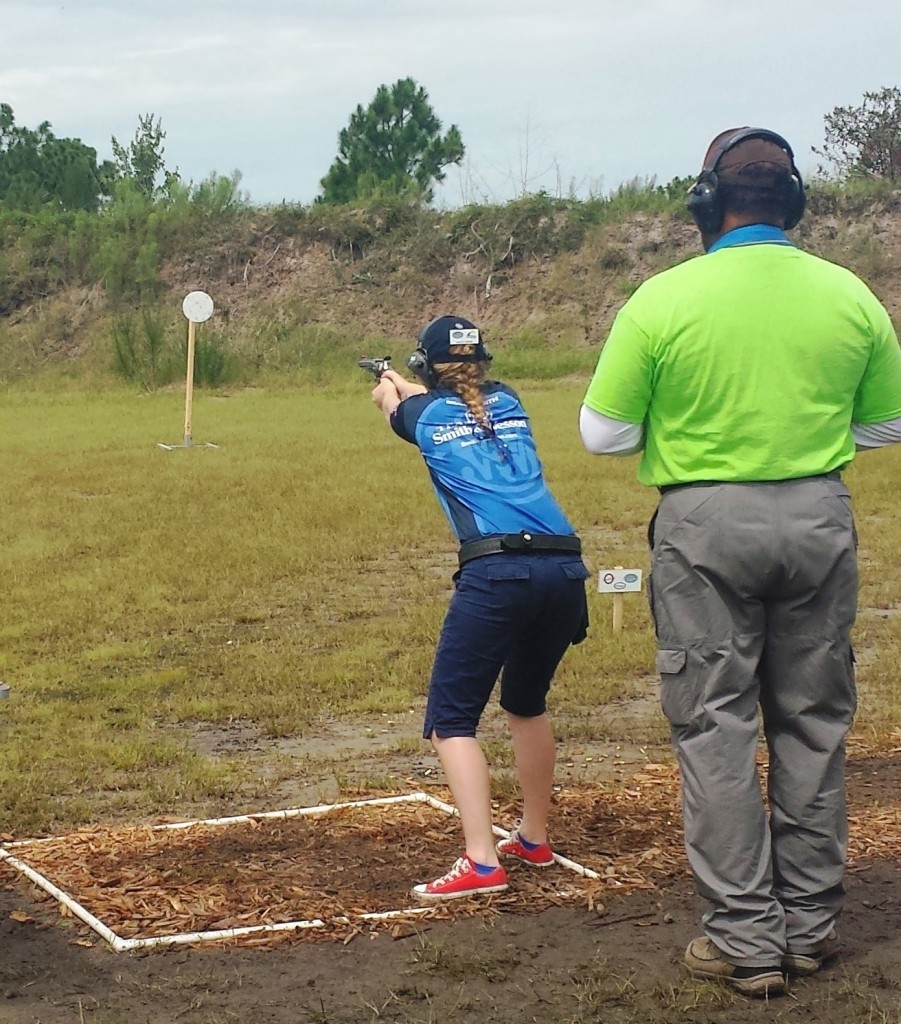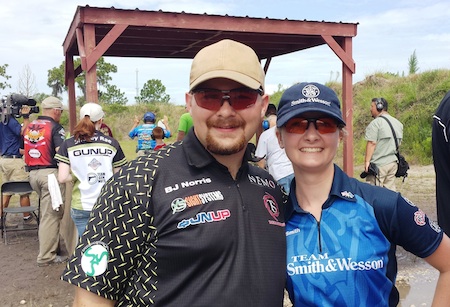There is a starting line for everything: for college – orientation, for a novel – page 1, and for a shooting career – the first match.
My first match, and the beginning of my love for competition, happened in 2008 at Steel Challenge World Championship. From the moment I first stepped on the dusty range in Piru, Calif., I knew it not only was going to truly be a “steel challenge,” but also a struggle that I looked forward to. After all, I had my Buckmark .22, my snacks and my friends! And, it was a great match.
What is Steel Challenge?
The Steel Challenge is a speed event, where there are always the same 8 stages with 5 plates, each stage (except 1) having 5 consecutive “runs/strings,” shooting the stage for a time. Then, the highest time is eliminated, and the top 4 runs are added together. This is done for each stage, and the total time is your score. Everyone competes to get the fastest possible time.

Molly Smith shooting the Outer Limits stage at the 2013 Steel Challenge World Championship. Remember: Lean in!
My Steel Challenge
Back then, I didn’t realize how instrumental the Steel Challenge would be in my development as a shooter. As I started to compete more, each match taught me more. In Bianchi Cup there is intense concentration to a more specialized degree than Steel because the “target area” is smaller and normally farther away. But Steel Challenge forced me to push myself on every string, as well as learn from my last run, in order to cut my time as much as possible. The fact that “accuracy” doesn’t count to the same extent, in the Steel Challenge, as the shooter will not get any bonus points if the plate is nicked or hit bull’s eye, really trains the shooter to focus on what does count – and that’s speed. However, I was quick to find out that without accuracy, my times would be SLOW. Each miss took time, and when runs average at about 3 seconds, that’s a lot of time. They say it takes accuracy first, and then speed comes. I would agree, but I recently reached a point where I would be accurate, but my times were not as impressive. I forced myself to speed up, and managed to cut my time down by about 10 seconds!
Something worth mentioning: I shoot a revolver. Most guns in the Steel Challenge are semi-automatics, which means that most competitive shooters shoot “open”—a category often designated for “race” guns with modifications and scopes. Shooting a revolver makes speed matches a little more challenging. The trigger pull is longer, and there are fewer cartridges in the cylinder than in a magazine (assuming they were both loaded all the way). My Smith & Wesson 627 holds 8 shots, but semi-automatics normally have 10 shots or more. I know that I can miss 3 times per string – but I don’t like to push it. Ideally, there are no misses, and I don’t have to take any make-up shots, which take extra time. That’s the advantage – a revolver forces you not to miss. I go into greater detail about shooting a revolver in an article over at GunUp that The WON’s publisher, Barbara Baird, wrote.

BJ Norris, Second Place Overall, and Molly Smith at the 2013 Steel Challenge World Championship. He’s also a great coach!
One thing I will add: there is so much inspiration from other revolver shooters to continue shooting a revolver. The friendships found between revolver-shooters are not comparable to any other shooting aspect I’ve encountered. Annette Aysen, a World Champion revolver shooter, is my revolver mentor. A great friend, she always is serious about shooting, generous with her love, encouragement, and insight.
The Steel Challenge is not just for the “pros,” but for new shooters as well. There is a .22 match, which makes the initial outlay far less costly than the extreme-race guns. This is how I started – local club matches where I would shoot a .22. Anyone can get involved, and as evidenced by the Briley West Coast Steel Championship, there were multiple families out there shooting the match. The Steel Challenge is the match I most recommend for new shooters because it’s simple and allows shooters to build their abilities to shoot accurately. And many ranges put on regular Steel Challenge matches. Check out how to get involved with the World Championship.
This past weekend I shot my revolver at the 2013 Steel Challenge World Championship. It was my first time competing in the Steel Challenge since it moved from Piru to Frostproof, Fla. Now, instead of dead-last, I took Second Place Iron Sighted Revolver. Many things were the same, like the stages, the similar snacks and of course those friends I have kept since I started 5 years ago.

World Champions Elliot Aysen, Annette Aysen, and Molly Smith at the 2013 Steel Challenge World Championship
Read more about Molly Smith’s adventures at her blog.
California teen shooter Molly Smith shoots for Team Smith & Wesson, and prefers a 627 Smith & Wesson iron-sighted revolver. She attends several matches each year, and loves to write about them at her column, "Millisecond Molly." View all posts by Molly Smith
Great article Molly! We are very proud of you! You are talented in so many ways!!